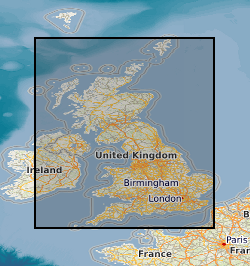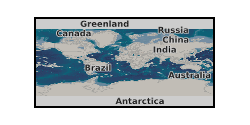2010
Type of resources
Available actions
Topics
Keywords
Contact for the resource
Provided by
Years
Formats
Representation types
Update frequencies
Service types
Scale
Resolution
-
HIRDLS was a mid-infrared limb-scanning radiometer (21 channels from 6.12 to 17.76 µm and provided sounding observations to observe the lower stratosphere with improved sensitivity and accuracy. HIRDLS was carried on the Aura mission, part of the A-train procession of polar orbiting satellites forming part of NASA's Earth Observing System (EOS). This dataset contains level 2 version 6.00 data of the global distributions of temperature, clouds, aerosols, and 10 trace species O3, H2O, CH4, N2O, NO2, HNO3, N2O5, CFC11, CFC12, and ClONO2 in the stratosphere and upper troposphere at high vertical and horizontal resolution in the Earth's atmosphere between about 8 and 100 km, from the High Resolution Dynamics Limb Sounder (HIRDLS) instrument.
-
RAPID-WATCH VALOR project investigated how the inclusion of RAPID-WATCH observations into the 'initial conditions', used to start climate model simulations, can refine predictions of the future climate and, particularly, the future state of the Atlantic Meridional Overturning Circulation (AMOC). This dataset collection contains Meteorology ECMWF Model output.
-
The overall aim of the UK Surface Ocean / Lower Atmosphere Study (UK SOLAS) is to advance understanding of environmentally significant interactions between the atmosphere and ocean, focusing on material exchanges that involve ocean productivity, atmospheric composition and climate. The knowledge obtained will improve the predictability of climate change and give insights into the distribution and fate of persistent pollutants. The dataset contains biological and chemical measurements such as: major nutrients and trace metal concentrations in aerosol and rain samples, chemical analyses of inorganic micro-nutrients, dissolved and particulate trace metal and carbon analyses, dissolved nitrogen and organic phosphate, biological measurements including phytoplankton pigments, bacteria, picoplankton and larger phytoplankton abundance.
-
This dataset contains Fire Radiative Power (FRP) data over Africa from Meteosat Second Generation (MSG) Spinning Enhanced Visible and InfraRed Imager (SEVIRI) data. Fires are detected by applying Roberts and Wooster's (2008) detection algorithm to SEVIRI data. FRP is estimated using the Middle InfraRed (MIR) radiance method (Wooster et al., 2003). The dataset was produced by Gareth Roberts and Martin Wooster (National Centre for Earth Observation (NCEO), Kings College London).
-
Data from observations made at the Cape Verde Atmospheric Observatory (CVAO) which exists to advance understanding of climatically significant interactions between the atmosphere and ocean and to provide a regional focal point and long-term data. The observatory is based on Calhau Island of São Vicente, Cape Verde at 16.848N, 24.871W, in the tropical Eastern North Atlantic Ocean, a region which is data poor but plays a key role in atmosphere-ocean interactions of climate-related and biogeochemical parameters including greenhouse gases. It is an open-ocean site that is representative of a region likely to be sensitive to future climate change, and is minimally influenced by local effects and intermittent continental pollution. The dataset contains mixing ratio measurements of NO, NO2 and NOy.
-

Data identifying landscape areas (shown as polygons) attributed with type of mass movement e.g. landslip. The scale of the data is 1:10 000 scale. Onshore coverage is partial with approximately 30% of England, Scotland and Wales available in the version 2 data release. BGS intend to continue developing coverage at this scale; current focus is to include all large priority urban areas, along with road and rail transport corridors. Mass movement describes areas where deposits have moved down slope under gravity to form landslips. These landslips can affect bedrock, superficial or artificial ground. Mass movement deposits are described in the BGS Rock Classification Scheme Volume 4. However the data also includes foundered strata, where ground has collapsed due to subsidence (this is not described in the Rock Classification Scheme). Caution should be exercised with this data; historically BGS has not always recorded mass movement events and due to the dynamic nature of occurrence significant changes may have occurred since the data was released. The data are available in vector format (containing the geometry of each feature linked to a database record describing their attributes) as ESRI shapefiles and are available under BGS data licence.
-

The RISCS (Research into Impacts and Safety in CO2 Storage) project assessed the potential environmental impacts of leakage from geological CO2 storage. Consideration was given to possible impacts on groundwater resources and on near surface ecosystems both onshore and offshore. The aim of the project was to assist storage site operators and regulators in assessing the potential impacts of leakage so that these could be considered during all phases of a storage project (project design, site characterisation, site operation, post-operation and site abandonment, and following transfer of liability back to the state). A secondary objective was to inform policy makers, politicians and the general public of the feasibility and long-term benefits and consequences of large-scale CO2 capture and storage (CCS) deployment. RISCS was a 4 year project supported by the European Commission under the 7th Framework Programme. Project website http://www.riscs-co2.eu.
-

The map shows the potential for the rocks to supply groundwater and the type of groundwater flow within the rocks. The dataset reattributes polygons in the Digital Geological Map Data of Great Britain - 625k (DiGMapGB-625) Bedrock version 5 dataset to indicate whether the bedrock is an aquifer, the type of flow through the aquifer (fracture and fissure flow or intergranular flow) and how productive the aquifer is likely to be. The dataset is based on the known hydrogeological properties of rock types. The dataset covers just the bedrock formations for the UK and the Isle of Man. The data can be used for planning, environmental analysis, water supply and hazards.
-
The Icelandic Volcano, Eyjafjallajokull, started erupting on 14th April 2010. The volcanic ash cloud produced covered much of Northern Europe for several weeks causing extensive disruption to air travel. The UK and European atmospheric communities had many instruments - both airborne and ground-based, remote sensing and in-situ - taking measurements of the ash cloud throughout this period. This dataset contains summaries of meteorology and chemistry measurements from the EUFAR operators SAFIRE Falcon and ATR 42 aircraft 19th to 21st April 2010 and DLR Falcon Flight on 19 April 2010
-
The objective of the ADIENT (Appraising the Direct Impacts of aErosol oN climaTe) project was quantifying the direct effect of aerosols on the Earth's radiation budget, via scattering and/or absorption of radiation. This daily data was a subset of the GlobAEROSOL climatology from the Advanced Along Track Scanning Radiometer (AATSR) instrument on-board Envisat, data for the period 24 July 2002 to 25 February 2009. This dataset contains measurements of the following parameters over the globe: Aerosol optical thickness taken at 550nm and 870nm, Angstrom Coefficient, Earth surface albedo taken at 550nm, 670nm, 870nm, and 1600nm. Upwelling spectral radiance in the air (measured reflectance) at 550nm, 670nm, 870nm, 1600nm, and 3700nm. Brightness temperature taken at 11000nm and 12000nm. Cloud area fraction Aerosol speciation (from a selection of 5 pre-defined types:maritime, continental, desert, urban/polluted and biomass burning).
 NERC Data Catalogue Service
NERC Data Catalogue Service